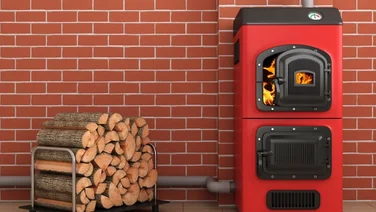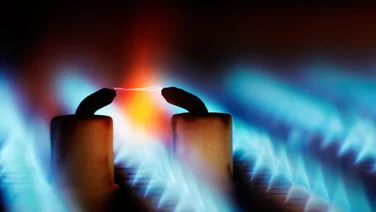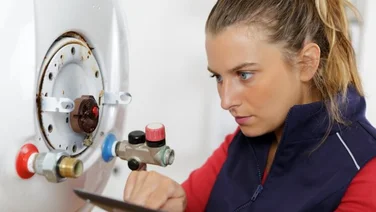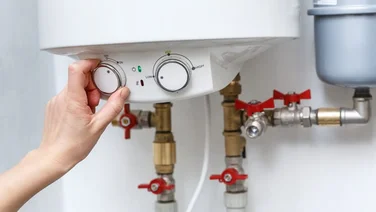- What is a Zero-Emissions Boiler (ZEB)?
- How do ZEBs work?
- What is ‘intelligent heating’?
- How efficient are ZEBs?
- Can a ZEB save me money?
- Are government grants available for ZEBs?
- Is my home right for a ZEB?
- Where should you install a ZEB?
- Are ZEBs better than gas boilers?
- How much is a ZEB?
- ZEB maintenance
- Next steps
- Zero-Emission Boilers (ZEBs) are all electric and 100% efficient
- ZEBs do not require venting or outdoor space to install
- ‘Intelligent heating’ learns your habits to minimise energy use

Since the 1970s, when they became widely adopted in the UK, gas boilers have been excellent pieces of kit for heating your home, but they have one major drawback: their carbon emissions.
Heat pumps are an alternative, but if you live in a flat, have no access to outside space, or live in a poorly insulated home, they may not be the right option for you.
If that’s the case, a new solution might be just what you’re looking for to save money and reduce your carbon emissions — a Zero-Emission Boiler (ZEB) from Tepeo.
Unlike traditional gas or oil boilers, ZEBs use electricity, which allows them to integrate with renewable energy sources like solar panels, or wind power.
As a result, they can provide heating and hot water with a significantly lower carbon footprint.
They can power up on energy at night, when electricity is cheaper, and intelligently manage your heating and hot water needs throughout the day.
What’s more, as they don’t produce any emissions directly, they will also help reduce your impact on the planet.
If that’s piqued your interest, read our guide for everything you need about ZEBs.
What is a Zero-Emissions Boiler (ZEB)?
Zero-Emissions Boilers (ZEBs) are electric boilers that are designed to be a direct replacement for a traditional gas boiler. They provide hot water for your radiators and underfloor heating system without burning fossil fuels like natural gas on your property.
They work similarly to electric storage heaters, by drawing electricity from the grid and converting it into heat for your home.
ZEBs can even be installed in homes with older boilers, such as back boilers. However, due to the location of back boilers within the home, removing them can take time, and the plumbing might need a review. That said, this would be the case for any replacement of a back boiler, regardless of what technology you are replacing it with.
How do ZEBs work?
ZEBs work by charging up on electricity off-peak, like a battery or an old electric storage heater.
The ZEB uses a mixture of specially designed high-density, inert, non-toxic, low-impact materials to act as a thermal (heat) battery. The key part is magnetite, a common iron ore that degrades slowly and is easily recyclable.
When heating or hot water is needed, air flows over the core and transfers heat to the heat exchanger. The water then flows through the heat exchanger and, once heated, it then travels to the radiators or hot water taps.
Tepeo’s ZEB can store around 40 kilowatt-hours (kWh) of usable heat energy per charge.
To put that into perspective, the average UK home uses around 1,000 kWh of energy per month. According to Ofgem, one kWh is enough to power a 100-watt lightbulb for 10 hours.
How do you install one?
When it comes to wet central heating systems, “the newer a system is, the better as it will be more efficient at distributing and using the heat generated by the ZEB or any other heat source,” Tepeo’s Chris Hughes, told The Eco Experts.
“The ZEB, however, doesn’t require you to change your plumbing, radiators or add underfloor heating to work well; it’s a great low-carbon solution which requires no retrofitting.”
We’ll cover more about how they work in the next section, but you can consider them an alternative to a heat pump or a replacement for your traditional oil or gas-fired boiler.
Unlike ‘combi’ gas boilers that you may be used to, ZEBs can only provide heating directly, which means that to provide hot water for your bath, shower, and taps, it will need to be connected to a separate hot water cylinder.
“The ZEB requires a separate hot water cylinder if there isn’t one in the property already,” explained Tepeo’s Erin Willis.
“It can be vented or unvented, and a standalone electrical hot water cylinder (PCM heat battery) will also work. It would fit better in larger properties so that the ZEB can focus its full capacity on space heating only.”
ZEBs like Tepeo’s are designed to replace your existing gas or oil boiler directly. They even have the same size and specification of hot water pipework as a modern gas boiler, which means they can be connected directly to your radiator system, with a little conversion.
They are also a good alternative to other systems like air source heat pumps (ASHP) that are not always appropriate for older properties in the UK.
What is ‘intelligent heating’?
‘Intelligent heating’ refers to heating systems that use advanced technologies, such as algorithms and Internet of Things (IoT) connectivity, to optimise energy use, enhance comfort, and minimise heating costs.
These systems can learn from your habits and preferences, automatically adjusting the heating schedule and temperature settings to match your daily routine and changing weather conditions.
Most ZEBs come with smart algorithms that can also factor in the carbon intensity of electricity for your home’s current tariff. Tepeo claims that it works best with “time of use” or ‘flexible’ tariffs, where you can take advantage of the cheapest electricity rates throughout the day.
Tepeo’s ZEB allows you to control how it stores energy by charging when it’s better for the environment or your bank account, using a simple sliding scale.
How long do ZEBs take to charge?
The boiler’s heat battery takes four to five hours to fully charge overnight from empty (a charging rate of about 9.3 kWh per hour). Tepeo claims that the boiler can deliver heat to your central heating system after only half an hour of charging.
The battery can be charged from the national grid and micro-generation systems like solar panels if you have them installed. The ZEB also uses something called a ‘smart algorithm’ to charge and discharge in as efficient a manner as needed. It can learn your heating habits and also consider the local weather, the time of year, and the energy use performance of your home.
When heating your home, Tepeo’s zero-emission boilers also use something called ‘intelligent heating.’’. The ZEB operates like a standard boiler with a heat exchanger and flow and return, but its well-insulated battery optimizes heat transfer throughout the system.

How efficient are ZEBs?
Since the zero-emission boiler is all-electric, it is considered 100% efficient compared to conventional gas boilers. This means that there are no losses in energy input to heat conversion. To put that into perspective, a typical modern gas boiler (like a condensing one) is at least 90% efficient. Older boilers can be anywhere from 70% upwards.
This doesn’t quite compare to the 300-400% efficiency that you can get from a heat pump, but it’s not bad.
Regarding its environmental impact, switching from a natural gas boiler to the ZEB should save you, on average, around 2 tonnes of CO2 emissions per year. This figure will vary widely depending on your home, but is based on an average heating demand of 12,000kWh/year.
Can a ZEB save me money?
Yes, but it depends on your home and energy consumption habits.
While some assumptions can be made to give you an idea, without an in-depth, personalised assessment (which Tepeo will provide for potential customers), it is not easy to say for sure.
For best results, Tepeo recommends their products for homes that use between 3,000 and 12,000 kWh a year for combined heating and hot water demands. If you have a recent Energy Performance Certificate on your property, you can also refer to that to get a “ballpark” figure.
A more accurate way to find out is by totting up your total energy costs from a year’s worth of bills. Both gas and electricity bills should give you a breakdown of the total kWh usage per billing period. However, remember that these totals, especially for electricity, will include consumption of other household appliances like your fridge, TV, lighting, etc.
Tepeo’s product director, Tatevik Zhamharyan explained: “the ZEB is most suitable for four-bedroom homes built after 2000, 3-bedroom homes built after 1930, and 1-2-bedroom homes built after the 1900s. The ideal annual energy usage should also be below 12,000 kWhs with a heat loss of 4-5 kW. Insulation and draught-proofing will help to minimise heat loss, making a home more suitable for the ZEB, as long as the above criteria are also met.”
It is important to note that changing your main heating system can result in additional costs that will impact a system’s return on investment.
For example, if you have a combination boiler, you must install a new separate hot water cylinder alongside the ZEB. As with heat pumps, it should also be noted that electricity is currently more expensive to use than gas.

Are government grants available for ZEBs?
Regarding incentives like ECO4, ZEB technology is still relatively new and not included in existing schemes. However, this may change in the future.
“The ZEB doesn’t currently benefit from VAT relief or subsidies, but we’re working on it. The Neat Heat trial was run with OVO offering a select group of customers the opportunity to have a ZEB installed free of charge with a bespoke tariff to support. That enabled more off-peak charging opportunities than other tariffs,” added Zhamharyan.
OVO offered a trial back in 2022 for ZEB boiler installations. As part of the UK Power Networks’ Neat Heat project, credits were offered to customers, allowing energy rates of as low as 12p/kWh when charging their boilers. This was far below the current guaranteed price of 34p/kWh, which would impact the expected return on investment.
Is my home right for a ZEB?
While ZEBs can save money and emissions, they are not appropriate for every home in the United Kingdom.
As mentioned, they are best suited for properties (no matter the size) that use between 3,000 and 12,000 kWh. They are only appropriate for properties with a ‘wet’ central heating system.
To give you an idea of the size of the home and the number of occupants a ZEB is best suited for, we’ve included a rough guide from Ofgem below. However, remember this is only a guide, and your personal energy use habits may be much lower or much higher.
| Energy Use | Home type and number of residents | Typical annual gas use (kWh) | Typical annual electricity use (kWh) |
|---|---|---|---|
| Low | Flat or 1-bedroom house; 1-2 people | 7,500 | 1,800 |
| Medium | 2-3 bedroom house; 2-3 people | 11,500 | 2,700 |
| High | 4+ bedroom home; 4-5 people | 17,000 | 4,100 |
Where should you install a ZEB?
ZEBs need sufficient space on a flat, solid surface to be installed, but as they don’t require a vent or access to the outdoors, lofts, cellars, and even utility rooms are ideal. Still, they require a solid internet connection to work effectively.
Some examples, like Tepeo’s ZEB, are 38.58 inches (98 cm) tall by 23.62 inches (60 cm) wide by 25.98 inches (66 cm) deep. They also need around 2.76 inches (7 cm) of clearance below the boiler and 1.97 inches (5 cm) on either side of the unit for best results.

Regarding internet connectivity, locations with thick walls or floors between the boiler and your router can influence the Wi-Fi signal connection. Such considerations will usually be assessed during a site survey to assess the most suitable location for the installation.
Are ZEBs better than gas boilers?
When it comes to running costs, while electricity is more expensive by the kWh, the ‘smart’ energy management and charging systems they come with should make them at least on par, if not better, for your wallet than a gas boiler.
Based on Energy Monitor calculations, a ZEB can also be compared with air-source heat pumps and gas boilers.
According to Tepeo estimates, the annual running cost of a ZEB is around £734, which compares to £1,917 for a direct electric boiler, £679 for a gas boiler, £799 for a high-temperature heat pump, and £701 for a low-temperature heat pump.
With ZEBs, there is very little chance of fire as they only use direct mains electricity. Unlike gas or conventional boilers, they don’t use any flammable substances.
When it comes to the environment, since zero-emission boilers use mains electric and can use micro-generated power from solar panels, they are effectively emission-free at the point of delivery.
Although the majority of mains electricity in the UK is still generated by burning fossil fuels, the energy mix of the UK’s national grid is greening over time, with more wind powering the grid and new initiatives to bring nuclear power stations online very soon.
How much is a ZEB?
Zero-emission boilers typically cost around £6,000 for the unit, with an additional installation cost of around £2,000. These prices are exclusive of VAT.
As previously mentioned, incurring additional costs for things like a new hot water cylinder may be necessary. This could add an extra £500 to £2,000 or more, depending on the size, type (vented or unvented), and pipework/installation complexity required.
To put that into perspective, a gas boiler usually costs around £4,000 plus VAT to install, and an air source heat pump system costs on average £10,000 plus VAT.
However, government grants for heat pumps like the Boiler Upgrade Scheme can reduce that cost by £5,000.
ZEB maintenance
Like any physical equipment, ZEBs require maintenance over their lifetime to keep them at peak performance.
However, unlike most conventional boilers or heat pumps, ZEBs tend to come with smart software that can self-diagnose issues and offer warnings via an accompanying smart device app.
Thankfully, companies like Tepeo offer a ten-year guarantee for their products, and you can add an ongoing health check for its ZEB for around £149 a year. They also offer a monthly £10 Care Plan.
Next steps
If you are now considering a ZEB, there are a few other things you should consider before taking the plunge:
- Firstly, you should consider what you are trying to achieve by replacing your old boiler. Are you looking to save money? Do you want to have less impact on the environment?
- If the former, installing insulation or other energy efficiency measures in your home may be cheaper. This could include loft insulation, draft proofing (this makes more of a difference than you think), or low-energy lightbulbs.
- Is your home compatible to have one installed? You can chat with installers or use tools like Tepeo’s pre-sales questionnaire to find out
- Do you have the space for one?
- The installation takes a few days, so can you do without heating and hot water? More details on what a typical installation covers can be found here.
- Make sure you get a few quotes from different installers to ensure you get the best value.
- Also, check with your local council for potential incentives for installing low-carbon energy systems.







